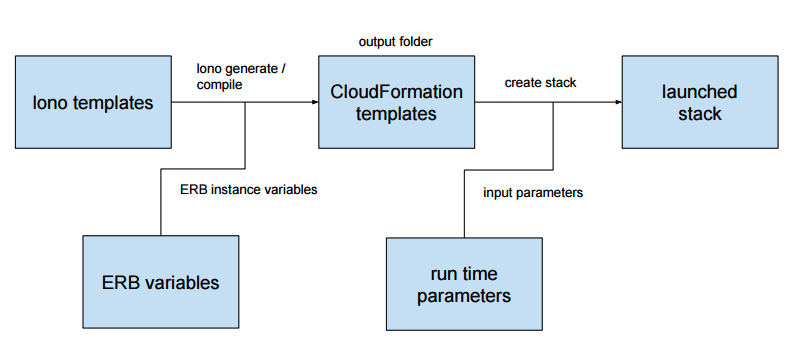
Lono
Lono is a tool to help you manage your CloudFormation templates. Lono handles the entire CloudFormation lifecyle. It helps you craft the templates and then provision the infrastructure.
- Lono generates CloudFormation templates based on ERB ruby templates in
yamlformat. - Lono takes simple env-like files and generates the CloudFormation parameter files.
- Lono provides a simple CLI interface to launch the CloudFormation stacks.
See lono.cloud for full lono documentation.
Important
If you are on version 3, you can run lono upgrade v3to4 within your project to upgrade it to version 4. Refer to the CHANGELOG.
If you are on version 4.0 or 4.1 and need to uppgrade to 4.2. You can run lono upgrade v4to4_2 within your project to upgrade it to version 4.2. Refer to the CHANGELOG.
Blog Posts
These blog posts also cover lono:
- Why Generate CloudFormation Templates with Lono
- Generating CloudFormation Templates with Lono
- AutoScaling CloudFormation Template with Lono
- CloudFormation Tools: lono, lono-params and lono cfn Together
- AWS CloudFormation dry-run with lono cfn preview
Quick Usage
It only takes a couple of commands to start using lono.
gem install lono
lono new infra
cd infra
lono import https://s3-us-west-2.amazonaws.com/cloudformation-templates-us-west-2/EC2InstanceWithSecurityGroupSample.template --name ec2
# update the generated params file
lono cfn create ec2

Lono Cfn Lifecycle Commands
Lono provides a lono cfn lifecycle command that allows you to launch stacks quickly. The lono cfn tool automatically runs lono generate internally and then launches the CloudFormation stack all in one command. If you are in a lono project and have a my-stack lono template definition. To create a stack you can simply run:
$ lono cfn create my-stack
The above command will generate files to output/templates/my-stack.json and output/params/my-stack.txt and use them to create a CloudFormation stack. Here are some more examples of cfn commands:
$ lono cfn create mystack-$(date +%Y%m%d%H%M%S) --template mystack --params mystack
$ lono cfn create mystack-$(date +%Y%m%d%H%M%S) # shorthand if template and params file matches.
$ lono cfn diff mystack-1493859659
$ lono cfn preview mystack-1493859659
$ lono cfn update mystack-1493859659
$ lono cfn delete mystack-1493859659
$ lono cfn create -h # getting help
See lono.cloud for full lono documentation.
Contributing
- Fork it
- Create your feature branch (
git checkout -b my-new-feature) - Commit your changes (
git commit -am 'Add some feature') - Push to the branch (
git push origin my-new-feature) - Create new Pull Request
Developing
There is a submodule in this project, so when you check out remember to sync the submodule.
$ git clone [email protected]:yourfork/lono.git
$ git submodule sync
$ git submodule update --init




